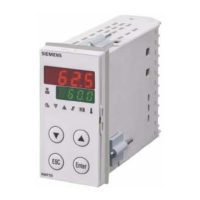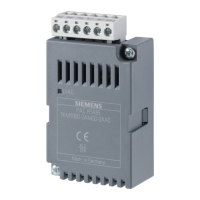84/126
Siemens Building Technologies Basic documentation RVD240 CE1P2384en
HVAC Products 23 Function block M-bus parameter 27.05.2004
23 Function block M-bus parameter
23.1 Operating lines
Line Function, parameter Unit
Factory
setting
Range
151 M-bus primary address 0 0...250
152 M-bus secondary address Display function
153 Baud rate Baud 2400 300 / 2400
154 Passing on the M-bus power control signals (Load Management) 0 0...2
155 M-bus power control in the heating circuit (Load Management) Display function
23.2 General
The M-bus to EN 1434-3 serves for reading setpoints and actual values. In addition,
individual end-user values can be written by the management system.
The remote setting of controller parameters via M-bus is not possible.
23.3 Addressing and identification
Addressing on the M-bus consists of a primary and a secondary address. The default
primary address is 0; the serial number is to be entered as the secondary address.
Both parts of the address can be changed via M-bus, the primary address on operating
line 151.
23.4 Baud rate
The Baud rate can be polled on operating line 153. For systems without automatic dis-
patch of the Baud rate to the slaves, the rate can be set.
23.5 Load management
23.5.1 Load management of d.h.w.
With load management of d.h.w., other d.h.w. setpoints can be imposed on the control-
ler via M-bus. This makes sense when there is too much or too little heat available at
the district heat connection.
When entering 0...4 on the M-bus master, the controller will respond as follows:
Input Response of controller
0 Load management deactivated
1 Corresponds to manual charging by pressing button
2 Corresponds to manual charging by pressing button , but d.h.w. is heated
up to the legionella setpoint
3 The current d.h.w. setpoint is the nominal setpoint minus the switching differ-
ential. The switching differential acts from the new setpoint
4 The current d.h.w. setpoint is the d.h.w. setpoint for frost protection
5 The current d.h.w. setpoint is the reduced d.h.w. setpoint
23.5.2 Load management of the heating system
Load management of the heating system uses internal locking signals or acts on the
demand for heat (refer to the relevant sections) in order to throttle or push the demand.

